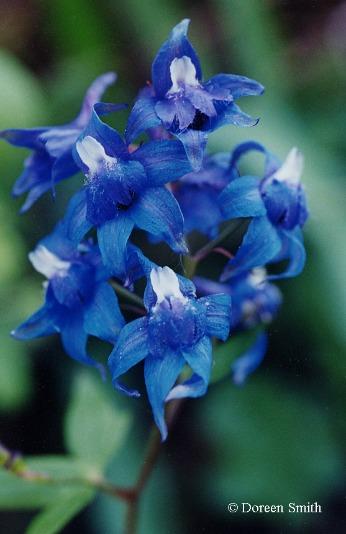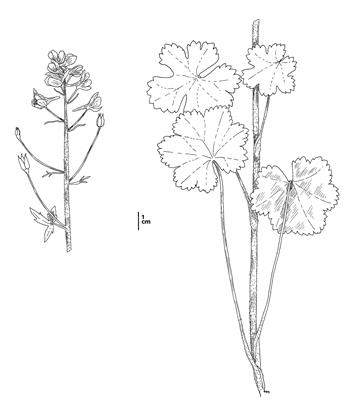(Delphinium bakeri)
 Delphinium bakeri. Photo © Doreen Smith.
Delphinium bakeri. Photo © Doreen Smith.
 Delphinium bakeri. CDFW illustration by Mary Ann Showers. (Click to enlarge)
Delphinium bakeri. CDFW illustration by Mary Ann Showers. (Click to enlarge)
Baker’s larkspur is a California endangered plant species, which means that killing or possessing plants is prohibited by the California Endangered Species Act (CESA). The species is also listed as endangered under the federal Endangered Species Act. Baker’s larkspur is a perennial herb of the buttercup family (Ranunculaceae), that grows in decomposed shale in mixed woodland plant communities of Marin County. It has dark blue flowers that typically bloom from April to May and is often pollinated by bees and hummingbirds. At the time of this webpage posting, the California Natural Diversity Database reports two natural occurrences of this species that are presumed to still exist, one along Marshall-Petaluma Road and the other in Tomales, both in Marin County. However, the U.S. Fish and Wildlife Service reported that the Tomales population was presumed extirpated by the time the species was listed under the federal Endangered Species Act in the year 2000. The type locality, reported from Coleman Valley in Sonoma County, has also been extirpated.
Threats to Baker’s larkspur include random events such as landslides, fire and vehicle accidents; herbivory by invertebrates and mammals (primarily banana slugs, snails, and gophers); human disturbance; trampling; low genetic variability; and agricultural conversion. The plant has little opportunity for population expansion due to urban development adjacent to populations. Because of the extreme range restrictions and small population size this plant is highly vulnerable to extinction.
Recovery efforts are ongoing for the plant and since March 2009 U.C. Berkeley Botanic Garden Staff have introduced Baker’s larkspur to three additional sites within its historic range. Two of the three locations are on privately owned agricultural areas and one is at the Marin Municipal Water District Soulajule Reservoir. The plant has a low natural abundance and has been difficult to establish as self-sustaining due, in part, to the fact that the plant has extreme range restrictions and is narrowly endemic, has a small population size, and requires moderately moist shaded conditions on a shallow veneer of soil along north facing slopes. The seed banking from greenhouse raised plants inadvertently selects for plants that thrive and set the most seed in artificial propagation. This may over time comprise the gene pool of wild-selected seeds and make it difficult for Baker’s larkspur to persist in these transplanted locations in the future.
CDFW may issue permits for Baker’s larkspur pursuant to CESA, and you can learn more about the California laws protecting Baker’s larkspur and other California native plants. Populations Baker’s larkspur occur in CDFW’s Bay Delta Region. More information is also available from the U.S. Fish and Wildlife Service Species Profile for Baker’s larkspur.